Master the Art of Stunning Flower Photography
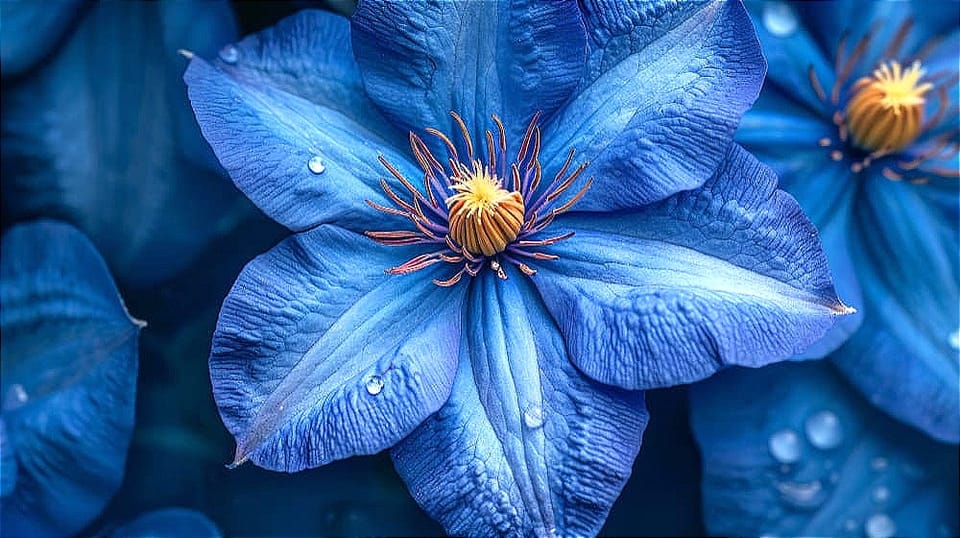
1. Introduction to Flower Photography
Understanding the Appeal of Flower Photography
Flower photography is one of the most rewarding genres for photographers of all levels. The vibrant colors, intricate patterns, and delicate textures of flowers offer endless opportunities to capture stunning images. Whether you're photographing a single bloom or a garden in full bloom, the beauty of nature provides an ever-changing canvas to inspire creativity. Unlike many other subjects, flowers are accessible almost anywhere, from your backyard to botanical gardens, making it a versatile and convenient area to explore.
Beyond its visual appeal, flower photography allows you to connect deeply with nature. It challenges you to observe details you might otherwise overlook, such as the subtle gradients of a petal or the play of sunlight on dew-covered blooms. This genre not only sharpens your technical skills but also nurtures a sense of mindfulness and appreciation for the natural world.
Why Mastering Flower Photography Matters
Mastering flower photography can elevate your portfolio and refine your artistic vision. While it might seem straightforward at first, capturing truly stunning flower images requires a thoughtful approach. Lighting, composition, and camera settings all play crucial roles in transforming a simple photo into a work of art. Understanding these elements helps you move beyond basic snapshots to create images that stand out.
Moreover, flower photography teaches you valuable techniques that translate into other genres. For instance, learning to manipulate depth of field for a flower close-up can improve your portraits, while perfecting your use of natural light can enhance your landscape shots. By mastering flower photography, you not only capture the ephemeral beauty of nature but also build a foundation for broader photographic success.
Affiliate Disclaimer
This blog post may include links to affiliate sites. If you click on an affiliate link and make a purchase, we may earn a small commission or receive other compensation at no extra cost to you. Please note that many of the links on our site are affiliate links. Our use of these links does not impact the products, services, or websites we recommend to you. This disclaimer covers all forms of communication with you, including our website, email, phone, social media, products, and other platforms.
2. Essential Gear for Stunning Flower Photography
Cameras and Lenses for Flower Photography
Choosing the right camera is a critical first step in capturing stunning flower photography. While any camera can technically photograph flowers, DSLR and mirrorless cameras offer superior control and image quality. These systems allow you to adjust key settings like aperture and shutter speed, essential for achieving the perfect depth of field or capturing delicate motion. For beginners, even high-end smartphones with advanced camera modes can be effective, though they lack the versatility of dedicated cameras.
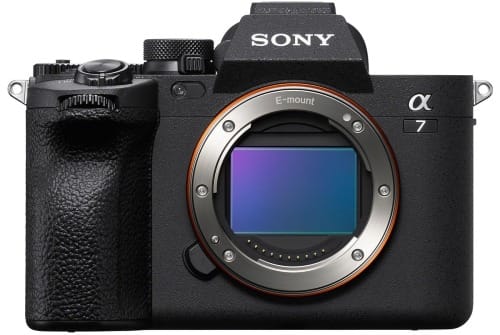
When it comes to lenses, macro lenses are the gold standard for flower photography. These lenses enable close focusing, allowing you to capture intricate details like the veins of a petal or the pollen on a stamen. A lens with a focal length of 90mm to 105mm is ideal for sharp, life-sized representations of flowers. Wide-angle lenses, on the other hand, are excellent for showcasing flowers in their natural environment, while telephoto lenses can isolate a bloom from its background for a more dramatic effect.

Additional Accessories to Elevate Your Shots
Accessories can make a significant difference in the quality and versatility of your flower photography. A tripod is indispensable for stability, especially when shooting in low light or attempting macro shots where even slight movements can result in blur. Look for a tripod with adjustable legs that can be positioned close to the ground for low-angle perspectives.
Other useful accessories include a remote shutter release, which eliminates camera shake when capturing fine details, and reflectors or diffusers to control and soften lighting. A set of extension tubes can also be a cost-effective way to achieve macro effects without investing in a dedicated macro lens.

The Role of Tripods in Steady Shots
Tripods play a pivotal role in flower photography, particularly when shooting with slower shutter speeds or in windy conditions. They provide the stability needed to ensure crisp, clear images and allow you to focus on composition without worrying about holding the camera steady. Combined with accessories like a macro rail, a tripod can make precision focusing easier, helping you achieve professional-level results.
3. Mastering Lighting Techniques
Using Natural Light for Flower Photography
Natural light is one of the most important factors in flower photography. The way sunlight interacts with flowers can dramatically influence the mood and quality of your images. Early morning and late afternoon are often considered the best times to shoot, as the soft, diffused light during these golden hours creates a gentle glow that enhances the natural beauty of flowers. This lighting also helps avoid harsh shadows and blown-out highlights that can occur under midday sun.
For an even softer effect, try shooting on overcast days. The clouds act as a natural diffuser, scattering light evenly and reducing contrast. This setup is perfect for capturing the subtle details and vibrant colors of flowers without the distractions of harsh lighting. Position yourself carefully to ensure the light falls in a way that enhances the texture and depth of the petals.

Diffusing Harsh Sunlight for Better Results
If you're photographing flowers during bright midday conditions, using diffusers can help you control the harshness of direct sunlight. A simple handheld diffuser or even a translucent white umbrella can soften the light, reducing the intensity of shadows and highlights. This adjustment is particularly important in macro flower photography, where details can easily be lost in extreme lighting.
Another approach is to use the shadows naturally available in the environment. Positioning yourself and the flower so that the light is filtered through nearby trees or other structures can add a dappled, artistic effect to your images. Experiment with angles to find the most flattering lighting setup for each shot.

Experimenting with Artificial Light
While natural light is ideal, artificial lighting can also be a valuable tool in flower photography. LED panels or ring lights can provide consistent illumination and allow for creative effects, such as backlighting to emphasize translucency in petals. When using artificial light, adjust the color temperature to mimic natural daylight for a more authentic look. Combine artificial lighting with natural elements, like soft diffusers or reflectors, to create a balanced and visually appealing composition.
By mastering these lighting techniques, you can elevate your flower photography, capturing blooms in their most stunning light and bringing out their delicate beauty.
4. Perfecting Composition
Rule of Thirds and Symmetry in Flower Photography
Composition is a critical aspect of flower photography, transforming an ordinary snapshot into a visually striking image. One of the most effective techniques is the rule of thirds. By dividing your frame into a grid of nine equal sections and placing your subject along these lines or at their intersections, you create a sense of balance and intrigue. For flower photography, this could mean positioning the bloom slightly off-center to draw the viewer's eye naturally into the frame.
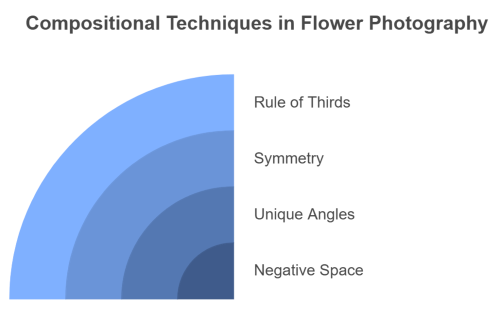
Symmetry is another powerful compositional tool. Many flowers are naturally symmetrical, and highlighting this characteristic can create compelling, harmonious images. Centering the flower in the frame can emphasize its symmetry, creating a clean and impactful composition. Experiment with both techniques to find what works best for your subject and the story you want to tell.
Exploring Unique Angles and Perspectives
Changing your perspective can dramatically alter the way flowers are perceived in your photography. Instead of shooting from above or straight on, try getting down to the level of the flower or even below it to capture the bloom against the sky. Low-angle shots can create a sense of grandeur, making small flowers appear larger than life.
Close-ups or macro shots allow you to showcase intricate details like the texture of petals, the curvature of stems, or the interplay of colors. Conversely, wide shots can capture the relationship between flowers and their environment, telling a broader story about their natural setting. Experimenting with angles and perspectives will help you develop a unique style in your flower photography.
Utilizing Negative Space for Impact
Negative space—the empty or open areas around your subject—can be a powerful compositional element in flower photography. Leaving space around a flower helps to isolate it and draw attention to its beauty, creating a minimalist and serene effect. For example, positioning a vibrant bloom against a plain blue sky or a softly blurred green background can enhance its visual impact.
By mastering these compositional techniques, you can create flower photography that not only captures the beauty of blooms but also evokes emotion and engages the viewer’s imagination.
5. Understanding Camera Settings
Aperture and Depth of Field for Flowers
In flower photography, the aperture plays a pivotal role in controlling the depth of field, which determines how much of the image is in focus. A wide aperture (low f-number, such as f/2.8 or f/4) creates a shallow depth of field, allowing you to isolate the flower by blurring the background. This technique is ideal for emphasizing the bloom’s intricate details while minimizing distractions.
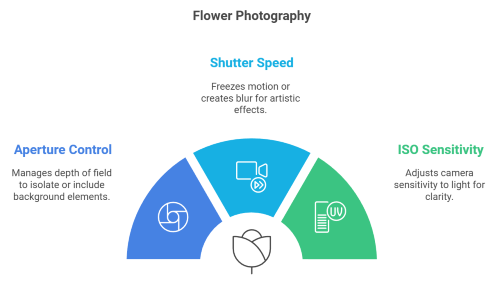
Conversely, a narrower aperture (higher f-number, like f/11 or f/16) increases the depth of field, keeping more of the scene in focus. This setting is perfect for capturing a group of flowers or incorporating their surrounding environment into the composition. Experimenting with different aperture values can help you find the right balance for each shot.
Shutter Speed and Motion Effects
Shutter speed is another critical setting in flower photography, particularly when dealing with movement caused by wind or when aiming for creative effects. A fast shutter speed, such as 1/500s or higher, freezes motion, ensuring sharp images even when flowers sway in the breeze. On the other hand, a slower shutter speed can be used creatively to capture intentional blur, adding a sense of motion to your shots.
ISO Settings for Crystal Clear Shots
ISO settings control your camera’s sensitivity to light. In flower photography, it’s best to use the lowest ISO setting possible to reduce noise and maintain image clarity. Adjust ISO only when necessary, such as in low-light conditions, and combine it with a tripod for stability.
Mastering these camera settings allows you to achieve greater control over your flower photography, producing consistently beautiful and professional-looking images.
6. Post-Processing to Enhance Flower Photography
Basic Edits for Vibrancy and Clarity
Post-processing is an essential step in flower photography, enabling you to enhance the natural beauty of your images. Start with basic edits like adjusting brightness, contrast, and saturation to make the colors pop while keeping them true to life. Flowers often display vibrant hues, and a slight boost in saturation or vibrancy can make them stand out without appearing unnatural. Clarity adjustments can also help emphasize the fine details of petals and textures.

Cropping is another simple yet effective tool for refining your composition. By removing distracting elements or repositioning your subject within the frame, you can draw more attention to the flower and improve the overall balance of your image.
Advanced Techniques for Artistic Effects
For more advanced editing, consider techniques like selective adjustments and layering. Selective adjustments allow you to enhance specific parts of the image, such as brightening a flower while keeping the background soft and muted. Adding a vignette can subtly direct the viewer's eye toward the bloom, creating a more dramatic effect.
Other artistic enhancements include experimenting with color grading to evoke certain moods or applying textures and overlays for creative flair. You can also use focus-stacking techniques during editing to combine multiple shots and achieve sharpness throughout the flower.
Recommended Software for Editing
Popular software options for flower photography include Adobe Lightroom and Photoshop, which offer robust tools for both basic and advanced edits. Apps like Snapseed or Luminar are user-friendly alternatives for quick and impactful adjustments, helping you bring out the best in your flower images.
7. Tips and Tricks for Stunning Flower Photography
Capturing Close-Ups and Macro Shots
One of the most captivating aspects of flower photography is the ability to capture intricate details through close-ups and macro shots. Using a macro lens or extension tubes allows you to magnify the subject and reveal textures and patterns that are often invisible to the naked eye. Focus on specific features such as the veins of petals, the pollen on stamens, or the delicate dew drops resting on a bloom. To ensure sharpness, use a tripod to eliminate any camera shake and rely on manual focus for precision.
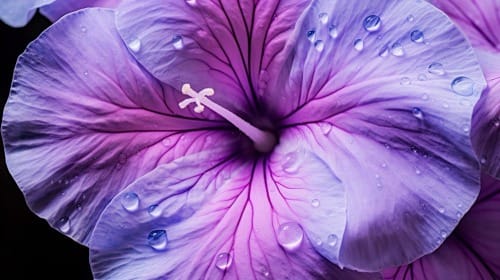
Shooting in Different Weather Conditions
Weather plays a significant role in flower photography, and each condition offers unique opportunities. Overcast skies provide soft, even lighting that reduces harsh shadows and highlights, making them ideal for capturing vibrant colors and fine details. Light rain can add a dramatic effect by creating natural water droplets on petals, enhancing the visual appeal of your shots. On sunny days, shoot during golden hours for warm, diffused light, or use a diffuser to soften the midday sun.
Seasonal Opportunities for Flower Photography
Different seasons bring diverse flowers and settings, offering endless opportunities for creativity. Spring is abundant with fresh blooms, perfect for capturing vibrant fields or garden shots. In summer, wildflowers and vibrant sunflowers are excellent subjects. Fall provides a chance to photograph flowers alongside rich autumnal tones, while winter’s frosted blooms create unique compositions.
These tips and tricks help you adapt to various conditions and expand your creative horizons, ensuring your flower photography continues to captivate.
8. Overcoming Common Challenges
Handling Windy Conditions
Windy conditions are one of the most common challenges in flower photography, as even a slight breeze can cause your subject to move, resulting in blurry images. To overcome this, use a fast shutter speed to freeze motion or bring along a windshield, such as a collapsible reflector or even a piece of cardboard, to block the breeze. Another effective solution is to shoot early in the morning or late in the evening when winds are typically calmer.

Using a tripod with a sturdy build can also help stabilize your camera in windy conditions. Pair this with a remote shutter release to minimize vibration and ensure sharper images. For small flowers, consider gently holding the stem still with a clip or clamp designed for photography.
Dealing with Poor Lighting
Poor lighting can make it difficult to capture the vibrant colors and intricate details that make flower photography so appealing. When natural light is insufficient, bring along a portable LED light or a ring light to illuminate your subject. Reflectors can also help bounce light onto the flower, brightening shadows and creating more even lighting.
If you’re shooting in low light, adjust your camera settings by increasing the ISO, widening the aperture, or slowing the shutter speed. A tripod is essential in these conditions to prevent camera shake.
Avoiding Common Mistakes
Common mistakes in flower photography include shooting in harsh sunlight, neglecting the background, or failing to focus on the right part of the flower. Always assess your environment and experiment with angles to avoid distractions and highlight the flower’s natural beauty. By addressing these challenges, you can consistently produce stunning flower photography.
9. Inspiring Ideas to Push Your Creativity
Adding Water Droplets for Drama
In flower photography, small details like water droplets can add a layer of intrigue and enhance the overall composition. Spraying a light mist of water onto the petals can simulate the effect of morning dew or gentle rain, creating a fresh and dynamic look. Water droplets catch and reflect light, adding depth and sparkle to your images. Position your light source to emphasize the glistening effect, and use a macro lens to capture the fine details of the droplets up close.
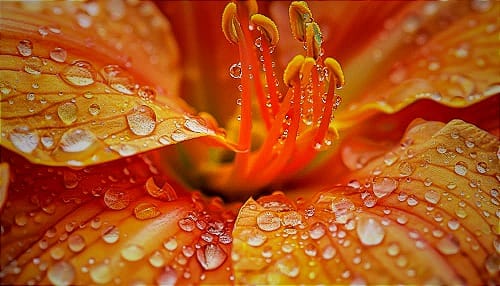
Shooting Flowers in Contextual Landscapes
While close-ups and macros are popular in flower photography, stepping back to capture flowers in their natural environment can tell a broader story. Include elements such as trees, mountains, or even a garden pathway to provide context and create a sense of place. Wide-angle lenses are great for capturing expansive scenes that showcase flowers as part of a larger landscape. This approach allows you to balance the beauty of individual blooms with the grandeur of their surroundings.
Playing with Color Contrasts
Flowers come in a variety of vibrant hues, making color contrast a powerful tool in flower photography. Pair bold colors with complementary backgrounds to make your subject stand out. For example, a bright yellow sunflower against a deep blue sky creates a striking visual impact. Experiment with monochromatic schemes as well, where flowers of similar shades create a harmonious and artistic composition.
These creative ideas can help elevate your flower photography, making your images stand out and leaving a lasting impression on viewers.
10. Conclusion
Recap of Key Techniques and Tips
Flower photography is a rewarding pursuit that combines technical skills with artistic expression. From mastering lighting techniques and composition to using the right gear, each element contributes to capturing stunning images of blooms. Remember to experiment with different camera settings, such as aperture for depth of field, shutter speed for motion, and ISO for clarity, to tailor your shots to the specific conditions and desired effects. Incorporating creative ideas like water droplets, contextual landscapes, and color contrasts can also elevate your work, giving your flower photography a unique and memorable touch.
Encouragement to Keep Practicing and Innovating
Like any art form, flower photography requires practice and patience to master. Don’t be discouraged by initial challenges or less-than-perfect results. Each shoot is an opportunity to learn and refine your skills. Experiment with new techniques, seek inspiration from other photographers and push your creative boundaries to develop your personal style. Nature is ever-changing, offering endless possibilities to explore and capture the beauty of flowers in different seasons, light conditions, and settings.
Invitation to Share Your Flower Photography Journey
Sharing your flower photography journey can inspire others and help you grow as an artist. Post your work on social media, participate in photography communities, or even start a portfolio or blog to showcase your images. Engaging with other photographers can provide valuable feedback and new ideas, fueling your passion and progress. Flower photography is not just about capturing blooms; it’s about celebrating nature’s beauty and expressing your vision through your lens.
FAQs
- What camera is best for flower photography?
Any camera can work, but DSLR or mirrorless cameras provide better control and image quality. Macro lenses are ideal for capturing details. - What time of day is best for flower photography?
Early morning and late afternoon are best for soft, diffused light. Overcast days also provide even lighting without harsh shadows. - How do I prevent blurry photos of flowers?
Use a tripod to stabilize your camera and a fast shutter speed to freeze motion, especially in windy conditions. - What lens should I use for flower photography?
Macro lenses are ideal for close-ups, while telephoto lenses isolate blooms from backgrounds. Wide-angle lenses work well for flowers in landscapes. - How can I make my flower photos more creative?
Experiment with water droplets, unique angles, and color contrasts. Play with lighting and include natural contexts for variety. - Do I need additional lighting for flower photography?
Natural light is usually sufficient, but reflectors, diffusers, or portable LED lights can help in low-light or harsh lighting conditions. - How can I improve the colors in my flower photos?
Adjust saturation, vibrancy, and contrast during post-processing while maintaining a natural look. Shoot in RAW format for better editing flexibility.
Thank you for visiting our site and being part of this journey with us! We rely on the generous support of visitors like you to continue providing high-quality. Your donation, no matter the size, helps us maintain the website and create more valuable resources for everyone.





